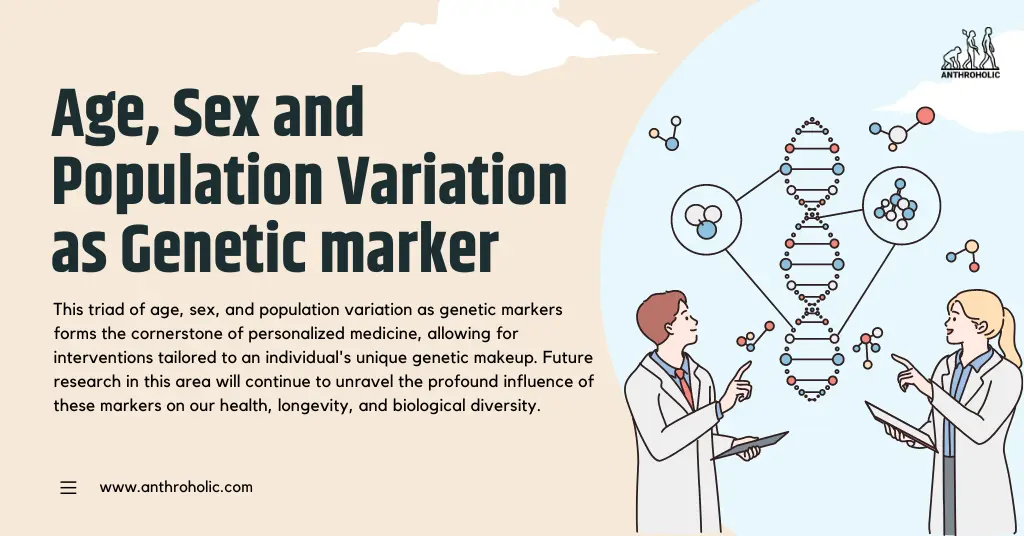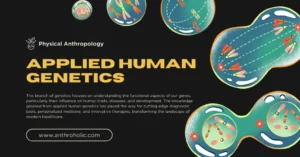AI Answer Evaluation Platform Live Now. Try Free Answer Evaluation Now
Age Sex and Population Variation as Genetic marker
Genetic markers are particular sequences of DNA that can be identified within the genome. They allow scientists to understand genetic variation and the role it plays in various attributes, including age, sex, and population variation [1].

Age as a Genetic Marker
Research has provided evidence that genetic variation may affect the rate of aging and lifespan. For instance, variants of specific genes have been associated with longevity and a decreased risk of age-related diseases [2].
A. Telomeres and Aging
Telomeres, which are protective caps on the ends of chromosomes, shorten with each cell division until they reach a critical length, at which point the cell becomes senescent or dies. This has led to the hypothesis that telomere length may serve as a biological marker of aging [3].
B. Mitochondrial DNA Mutations
Mitochondrial DNA mutations accumulate with age, and the number of these mutations can be used as a genetic marker for biological age. High levels of mitochondrial DNA mutations have been associated with an increased risk of various age-related diseases, such as Alzheimer’s disease [4].
| Age-Related Genetic Markers | Impact on Aging |
|---|---|
| Telomere shortening | Accelerates cellular aging |
| Mitochondrial DNA mutations | Increases the risk of age-related diseases |
Sex as a Genetic Marker
Sex is genetically determined, and genetic markers can be used to identify sex in humans and other species. In mammals, the Y chromosome is unique to males and can be used as a genetic marker for sex [5].
A. SRY Gene
The SRY gene on the Y chromosome is the key determinant of male sex in mammals. Its presence usually indicates a male, and its absence usually indicates a female [6].
B. X and Y STRs
Short Tandem Repeats (STRs) on the X and Y chromosomes are often used as genetic markers to determine sex, especially in forensic science [7].
| Sex-Related Genetic Markers | Role |
|---|---|
| SRY Gene | Determines male sex |
| X and Y STRs | Used to determine sex in forensic science |
Population Variation as a Genetic Marker
Genetic markers can also be used to study population variation. These variations occur due to factors like migration, genetic drift, mutation, and natural selection [8].
A. SNP (Single Nucleotide Polymorphism)
SNPs represent a change in a single DNA base pair in the genome. SNPs can be used to distinguish between different populations based on genetic differences [9].
B. Haplogroups
Haplogroups, which are groups of similar haplotypes, can indicate a common ancestor or similar geographical origins, making them useful for studying population variation [10].
| Population Variation Markers | Use |
|---|---|
| SNP | Differentiate between populations |
| Haplogroups | Indicate common ancestry or geographical origins |
Genetic Markers: Interplay of Age, Sex, and Population Variation
While the importance of age, sex, and population variation as individual genetic markers is well understood, their interplay also offers interesting areas of research. The interaction of these genetic markers can have profound implications for the susceptibility, progression, and treatment of various diseases.
A. Impact of Age and Sex on Disease Susceptibility
Certain diseases, such as osteoporosis and Alzheimer’s disease, show a distinct pattern of susceptibility based on both age and sex. Post-menopausal women are more susceptible to osteoporosis due to the decreased estrogen levels associated with menopause [11]. Similarly, studies have found that women are more susceptible to Alzheimer’s disease than men, and the risk increases with age [12].
B. Influence of Population Variation on Disease Prevalence
Population variation has significant impacts on the prevalence and manifestation of diseases. For example, the BRCA1 gene mutation, linked to breast and ovarian cancer, shows different frequencies across populations. Ashkenazi Jewish women are at a higher risk due to a higher frequency of this mutation [13].
| Interaction of Genetic Markers | Impact on Disease |
|---|---|
| Age and Sex | Alters susceptibility to osteoporosis and Alzheimer’s disease |
| Population Variation | Affects prevalence and manifestation of diseases such as breast and ovarian cancer |
Conclusion
Understanding age, sex, and population variation as genetic markers allows scientists to map the landscape of genetic diversity and its impacts on human health. Age-related genetic markers contribute to our understanding of lifespan and age-related diseases. Sex-based genetic markers can identify biological sex and explain sex-linked traits and diseases. Lastly, population variation markers are vital for tracing human migrations and understanding population-specific disease risks.
This triad of age, sex, and population variation as genetic markers forms the cornerstone of personalized medicine, allowing for interventions tailored to an individual’s unique genetic makeup. Future research in this area will continue to unravel the profound influence of these markers on our health, longevity, and biological diversity.
References
[1] Mardis E.R. (2008) Next-Generation DNA Sequencing Methods. Annual Review of Genomics and Human Genetics, 9(1), 387-402.
[2] Partridge L., Deelen J., Slagboom P.E. (2018) Facing up to the global challenges of ageing. Nature, 561(7721), 45-56.
[3] Blackburn E.H., Epel E.S., Lin J. (2015) Human telomere biology: A contributory and interactive factor in aging, disease risks, and protection. Science, 350(6265), 1193-1198. https://doi.org/10.1126/science.aab3389
[4] Chinnery P.F., Hudson G. (2013) Mitochondrial genetics. British Medical Bulletin, 106(1), 135-159.
[5] Skaletsky H., Kuroda-Kawaguchi T., Minx P.J., et al. (2003) The male-specific region of the human Y chromosome is a mosaic of discrete sequence classes. Nature, 423(6942), 674-679. http://dx.doi.org/10.1038/nature01722
[6] Koopman P. (1995) Sry and Sox9: mammalian testis-determining genes. Cell and Molecular Life Sciences, 51(6), 671-680.
[7] Sullivan K.M., Mannucci A., Kimpton C.P., Gill P. (1993) A rapid and quantitative DNA sex test: fluorescence-based PCR analysis of X–Y homologous gene amelogenin. BioTechniques, 15(4), 636-641. https://pubmed.ncbi.nlm.nih.gov/8251166/
[8] Cavalli-Sforza L.L., Feldman M.W. (2003) The application of molecular genetic approaches to the study of human evolution. Nature Genetics, 33(3s), 266-275.
[9] Sachidanandam R., Weissman D., Schmidt S.C., et al. (2001) A map of human genome sequence variation containing 1.42 million single nucleotide polymorphisms. Nature, 409(6822), 928-933.
[10] Underhill P.A., Kivisild T. (2007) Use of y chromosome and mitochondrial DNA population structure in tracing human migrations. Annual Review of Genetics, 41, 539-564.
[11] Khosla S., Riggs B.L. (2005) Pathophysiology of age-related bone loss and osteoporosis. Endocrinology and Metabolism Clinics of North America, 34(4), 1015-1030.
[12] Mielke M.M., Vemuri P., Rocca W.A. (2014) Clinical epidemiology of Alzheimer’s disease: assessing sex and gender differences. Clinical Epidemiology, 6, 37-48.
[13] King M.C., Marks J.H., Mandell J.B. (2003) Breast and ovarian cancer risks due to inherited mutations in BRCA1 and BRCA2. Science, 302(5645), 643-646.




